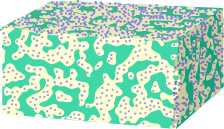Research Roundup
Harnessing the building blocks of polymer recycling

An alternate route toward a more sustainable polymer industry is to increase the service lifetime of polymers. An intriguing new concept is to impart the ability to “self-heal” from structural damage. Michael Bockstaller, professor of materials science and engineering, in collaboration with Krzysztof Matyjaszewski, J.C. Warner University Professor of Natural Sciences, has discovered that the binding of copolymers on the surface of nanoparticles that are already used in industrial manufacturing provides an economic and scalable route toward self-healing polymers with increased strength and toughness.
Normally when you think of the building blocks of materials you think of atoms. In Bockstaller’s research group, this concept inspired a new approach to fabricate functional materials by assembling nanoparticle building blocks using a form of atom transfer radical polymerization, a technique invented and developed by Matyjaszewski. The properties of the resulting materials can be varied by controlling the interactions between nanoparticle building blocks. This concept opens up new possibilities to vary properties of engineering materials without having to change their chemical composition — a feature that is highly beneficial in the context of recyclability.
While working to make these particles more amenable for fabrication technologies like additive manufacturing, Bockstaller’s team experimented with putting copolymers at the surface of nanoparticles.
“If we can put polymers on the surface of nanoparticles, we can improve the interactions between them and make materials more mechanically robust and easier to form,” Bockstaller said.
Adds Matyjaszewski, “This work illustrates how controlling macromolecular architecture can dramatically enhance properties of various advanced materials.”
Copolymers are a special class of polymers that are made up of two different monomers and exhibit self-healing properties. The researchers found that when copolymers were added onto the surface of nanoparticles, new structures were formed that enhanced the polymer’s self-healing properties. This discovery is foundational to improving the recyclability of polymers.
“This enables us to avoid material failure,” Bockstaller explained. “If the material can self-heal, we reduce the need to discard materials damaged by stress.”
Bockstaller’s group will continue to explore strategies to maximize strength and toughness of copolymer-based self-healing materials and to make them available to scalable production methods.
This research was published in Macromolecules.
■ Kaitlyn Landram
Non-heme iron enzymes form aziridine from free-standing amino acids

Chemists from Carnegie Mellon University and North Carolina State University have identified two enzymes that can catalyze the stereo-specific formation of aziridine, a compound found in many natural products with potent antibiotic and antitumor activities. While nature has perfected aziridine formation, synthesizing aziridine and using it as a key intermediate to power chemical reactions is still challenging.
In the new work, published in the Journal of the American Chemical Society, the researchers determined on a molecular-level how two newly discovered iron-containing enzymes form aziridine from free-standing amino acids, a step toward repurposing these types of enzymes to perform larger-scale synthesis.
Aziridines — three-membered rings made up of two carbons and a nitrogen—are found in several natural products isolated mainly from bacteria and fungi.
“You can find a lot of these types of enzymes in nature. They do incredible chemistry that synthetic chemists can only dream of,” said Associate Professor of Chemistry Yisong (Alex) Guo. “Our study is fundamental, but the bigger implication is that if we can figure out how the enzymes’ structure modulates their chemical reactivity, we can use that knowledge to develop novel synthetic methodology for natural product synthesis for antibiotic development and anti-cancer research.”
To gain better insight into how nature forms aziridine, Guo and his colleague Wei-chen Chang, associate professor of chemistry at NCSU, turned to the fungus Penicillium aethiopicum, which has a nonheme iron-containing enzyme (paTqaL) that catalyzes aziridination from a free-standing amino acid, valine. Using paTqaL’s gene sequence, Chang searched a gene database for potential aziridinases, zeroing in on two: one from the fungus Hypocrea atroviridis (haTqaL) and one from the fungus Penicillium digitatum (pdTqaL).
After confirming that the enzymes generate aziridine from valine, Chang fed the enzymes with several different amino acid substrates. Depending on the substrate provided, the enzymes generated aziridine with different stereo-specificity. Interestingly, the type of substrate could alter the reactivity so that the enzyme carried out hydroxylation instead of aziridination.
Guo, along with graduate student Jared Paris and senior Martha Spletzer, dug deeper into the reaction mechanism. They carried out transient kinetics studies and spectroscopic characterizations to reveal the specific carbon site on the substrate where the initial oxidative activation occurs. They also discovered the key iron-based reactive intermediate responsible for aziridine and hydroxylation product formation.
Funding for the Carnegie Mellon portion of the study was provided by a grant from the National Institutes of Health and Carnegie Mellon’s Summer Undergraduate Research Fellowship.
■ Amy Pavlak Laird
